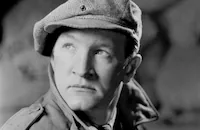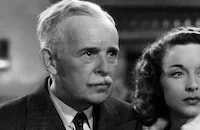Motor Madness
Cast & Crew
D. Ross Lederman
Rosalind Keith
Allen Brook
Marc Lawrence
Richard Terry
J. M. Kerrigan
Film Details
Technical Specs

Synopsis
Joe Dunn, a speed boat driver for boat builder Cap H. J. McNeil, who is also the father of Joe's girl friend Peggy, shows off his vessel in order to obtain support from Mr. Lewis of the Marine Sales Corporation. During race trials, Joe and Cap's rival, Pete Bailey, who is backed by a group of mobsters, tie for the fastest time. Joe is invited on board a gambling ship where Lucky Raymond tries to bribe him to stay out of the race. A fight ensues, and Joe is arrested by Coast Guard officer, Steve Dolan, who wants to win Peggy's affection as well. Joe is unable to make his bail, so Peggy takes his place at the boat's helm for the race. Peggy is seriously injured when the boat hits a buoy, and Joe is informed that the surgery will cost $1,000. Joe seeks Lucky's help and is refused until Lucky realizes he needs someone to smuggle in a group of gangsters. Joe agrees to do the job for Lucky but during the trip, they are chased by the Coast Guard. To prevent capture, one of the mobsters fires at the Coast Guard boat and wounds commanding officer Mike Burns. After Joe hands the smuggled mobsters over to Lucky, he pays Peggy's doctor and swears him to secrecy, but a young friend of Joe, nicknamed Pancho Villa, reveals to Peggy the identity of her patron. On the day of the final race, Cap asks Joe to drive his boat, but Steve is prepared to arrest Joe for smuggling. However, Joe convinces Steve to wait until after the race. Meanwhile, Pancho has been kidnapped by the mobsters because he knows too much, so when the race begins, Joe goes off course and pursued by the Coast Guard, heads for the gambling vessel. Once aboard the ship, Joe and the Coast Guard round up the gangsters and save Pancho. Steve then decides to forget about Joe's part in the smuggling and Joe and Peggy are happily united.

Director

D. Ross Lederman
Cast
Rosalind Keith
Allen Brook
Marc Lawrence
Richard Terry

J. M. Kerrigan
Arthur Loft

Joseph Sawyer
George Ernest
Al Hill
John Tyrrell
Ralph Byrd

Howard C. Hickman
Martha Tibbetts
Matty Fain
John Dilson
Nick Copeland

James Flavin
Lee Prather
Earl M. Pingree
Harry Bernard
George Chesebro
Harry Depp

Wilfred Lucas
Sammy Mckim
Allen Fox
Edward Laughton
Carlton E. Griffin
Tom O'grady
Pat O'shea
Dick Curtis
Eddie Fetherston
Ray Bennett
Crew

Film Details
Technical Specs

Articles
Marc Lawrence (1910-2005)
Born Max Goldsmith on February 17, 1910, in the Bronx, Lawrence had his heart set on a career in drama right out of high school. He enrolled at City College of New York to study theatre, and in 1930, he worked under famed stage actress Eva Le Gallienne. Anxious for a career in movies, Lawrence moved to Hollywood in 1932 and found work immediately as a contract player with Warner Bros. (an ideal studio for the actor since they specialized in crime dramas). He was cast as a heavy in his first film, If I Had a Million (1932). Although his first few parts were uncredited, Lawrence's roles grew more prominent: a sinister henchman in the Paul Muni vehicle in Dr. Socrates (1935); a conniving convict aiding Pat O'Brien in San Quentin (1937); a menacing thug stalking Dorothy Lamour in Johnny Apollo (1940); the shrewdly observant chauffeur in Alan Ladd's breakthrough hit This Gun For Hire (1942); and one of his most memorable roles as Ziggy, a fedora wearing mobster in the Bogart-Bacall noir classic Key Largo (1948).
Lawrence, when given the opportunity, could play against type: as the prosecuting attorney challenging Tyrone Power in Brigham Young (1940); a noble aristocrat in the Greer Garson-Walter Pidgeon period opus Blossoms in the Dust; and most impressively, as a deaf mute simpleton in the rustic drama The Shepherd of the Hills (both 1941). Better still was Lawrence's skill at comedy, where his deadpan toughness worked terrifically as a straight man against the likes of Joe E. Brown in Beware Spooks (1939); Abbott and Costello in Hit the Ice (1943); Penny Singleton in Life with Blondie (1945); and Bob Hope in My Favorite Spy (1951).
After that, Lawrence's career took a turn downward spin when he was labeled a communist sympathizer during the Hollywood witch hunts of the early '50s. He was exiled in Europe for a spell (1951-59), and when he came back, the film industry turned a blind eye to him, but television overcompensated for that. Here he played effective villains (what else?) in a series of crime caper programs: Peter Gunn, Johnny Staccato, The Untouchables, Richard Diamond, Private Detective; and eventually made a welcome return to the big screen as a returning exiled gangster in William Asher's underrated mob thriller Johnny Cool (1963).
It wasn't long before Lawrence found himself back in the fray playing in some big box-office hits over the next two decades: Diamonds Are Forever (1971), The Man with the Golden Gun (1974), Marathon Man (1976), Foul Play (1978); and The Big Easy (1987). Sure he was cast as a gangster, but nobody could play a rough and tumble mob boss with more style or conviction.
Interestingly, one of his finest performances in recent years was in television, as a severely ill old man unwilling to accept his fate in a fourth season episode of ER (1997-98). His last screen role was just two years ago, as a nimble minded VP in Looney Tunes: Back in Action (2003).
In 1991, Lawrence published a memoir about his venerable career, Long Time No See: Confessions of a Hollywood Gangster that received much critical acclaim. He has also developed a cult following due to his appearances in such offbeat items as From Dusk to Dawn and Pigs aka Daddy's Deadly Darling, the 1972 horror film he directed and starred in with his daughter Toni. He is survived by his wife, Alicia; two children from a previous marriage, Toni and Michael; and a stepdaughter Marina.
by Michael T. Toole

Marc Lawrence (1910-2005)
Quotes
Trivia
Notes
The working title of this film was Speed Mad. According to the Variety review, Motor Madness was an "introductory vehicle for Allen Brook." Motor Madness is a remake of Columbia's 1932 film Speed Demon (see below), also directed by Lederman and starring William Collier, Jr. and Joan Marsh.














